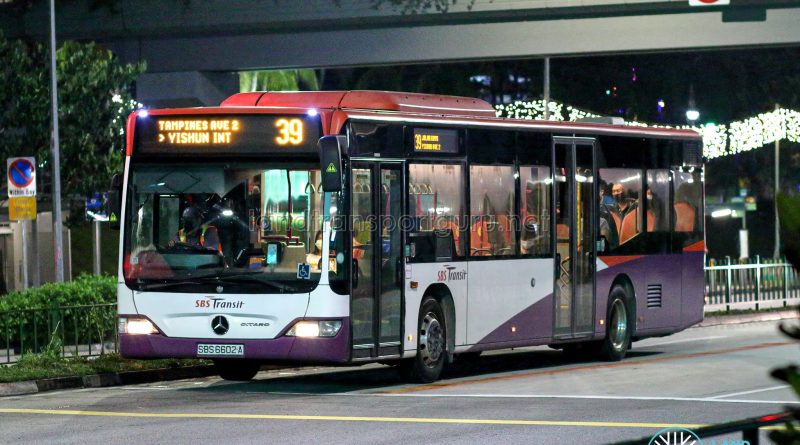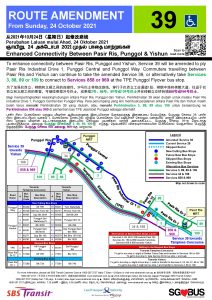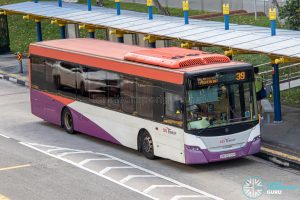Transport planning is an unenviable task of balancing the needs of commuters with the efficient use of resources. While unprofitable and underutilized bus routes have been curtained in the past, the recent move to amend Service 39 has struck discord with residents of Pasir Ris and Yishun, with members of the public calling for a stop to this arrangement.
Since 2009, the Land Transport Authority (LTA) had took on the role of being a centralised bus planning agency; a role which was further strengthened in 2016 with the advent of the Bus Contracting Model, allowing it to take control over service levels. LTA’s role as a centralised bus planning agency ‘allows it greater flexibility to respond to changes in bus service levels’.
The original planned amendment
As announced on 19 September 2021 on the Facebook page of Mr Teo Chee Hean, Member of Parliament (MP) for Pasir Ris-Punggol GRC, Bus Service 39 would be amended to serve Punggol New Town via the newly extended Pasir Ris Industrial Drive 1, skipping 2 pairs of bus stops along Pasir Ris Drive 12 and TPE.
Prior to the extension of Pasir Ris Industrial Drive 1 to link up with Punggol Central, residents of Pasir Ris and Punggol have long relied on the TPE to connect between the 2 estates. Since 19 October 2003, Service 3 has served as the main bus service connection between Pasir Ris and Punggol, but takes a slight detour via Pasir Ris Street 71 and Punggol Field before reaching their respective town centres.
With the opening of the extended Pasir Ris Industrial Drive 1 earlier this year, consultations have been conducted between the residents of Pasir Ris and Punggol with the MPs of Pasir Ris-Punggol GRC to introduce a bus service that provides a faster connection between the 2 estates via the extended road.
19 September 2021 – Public Reactions
These amendments were first announced in a Facebook post by Mr Teo Chee Hean on Sunday, 19 September 2021, slightly more than a month ahead of the bus service amendment. Public reactions to this bus route amendment were mixed, with more disapproving reactions than positive comments. Most discontent was directed to the extended travel duration between Pasir Ris and Yishun, after the service is amended to travel through Punggol.
Our take on Service 39
We present the following for and against the amendment of Service 39, along with potential outcomes.
Reasons for retaining existing route for Service 39
1. Complement loading on Bus Service 88/89/109/858/969
With many Pasir Ris residents relying on Services 88, 89 and 109 between Pasir Ris and TPE, as well as Services 858 and 969 between Yishun and TPE, Service 39 serves to distribute out the crowds on these trunk routes.
2. Duplicity of future Cross Island Line (CRL)
The proposed amended route for Service 39 will duplicate the Punggol Extension of the future Cross Island Line (CRL) between Pasir Ris and Punggol, which is scheduled for completion in 2031.
When the Punggol Extension opens in 2031, commuters who use the amended Service 39 will more likely prefer to take the new MRT line over the bus, which leads to an excess supply of public transport resources to provide connections that are better catered by the MRT.
3. Increased travel time and hassle
For Pasir Ris and Yishun residents, alternatives offered to Service 39 involve taking Services 89 or 109 to the TPE bus stops and transferring to Services 858 or 969 to get to Yishun, or Services 168 or 858 to Jln Kayu.
However, the need to transfer between multiple bus routes is an added inconvenience to Pasir Ris and Yishun residents. This also increases travel time to destinations to other areas in the Northern region of Singapore, specifically for the residents of Pasir Ris, who already lack other alternative travel options besides Service 39. Additionally, residents have pointed out that Services 858 and 969 are already overcrowded during the peak hours.
4. Car-lite nation
In recent years, the LTA has pursued the long-term strategy of cultivating a car-lite nation, in part by improving the speed and connectivity of public transport. In its Land Transport Master Plan (LTMP) 2040, it also envisions a ‘45-minute city’, where most commuters would spend no more than 45 minutes to complete journeys between their home and workplace.
It would seem like the move by LTA to lengthen long-distance expressway bus routes contradicts its long-term strategy for promoting a car-lite society. The move to lengthen the route of Service 39 reduces the attractiveness of the bus service for Pasir Ris and Yishun residents travelling between the 2 estates. Moreover, the proposed amendment only benefits a smaller minority of commuters who prefer a faster bus service connection between Pasir Ris and Punggol.
Reasons for amending the route of Service 39
1. Availability of existing public transport connections
Pasir Ris already benefits from stronger public bus connections to the Northern region of Singapore since the opening of Tampines Expressway (Punggol Road) Bus Interchange in 2014. Services 3, 88, 89 and 109 offer direct connections between Pasir Ris and the bus stops along TPE, which can be utilised to connect to other bus services heading towards the Northern region of Singapore.
Yishun has even more public bus connections to the Eastern and Northeastern regions of Singapore since the late 1990s and early 2000s with the route extension of Service 858 (1997) and introduction of Services 969 (2001), 965 (2002) and 85 (2006). In addition, Service 117 was introduced in 2015 under the Bus Service Enhancement Programme (BSEP), providing additional links from Yishun to the Seletar Aerospace Park and Punggol New Town.
Currently, LTA’s approach to building up the public transport network revolves around the hub and spoke model, where the rail network forms the backbone of the public transport network, and feeder bus services connecting these transport nodes with residential estates. This concept allows more origin and destination pairs to be served, by transferring between different modes of public transport (bus or train) that can be maintained at high frequencies.
2. Duplicity of existing bus routes
Service 39 is fully duplicated by other bus routes along the skipped sectors post-amendment, such as:
- Services 88, 89, 109: between Pasir Ris Dr 12 and TPE
- Services 168, 858: between TPE and Jalan Kayu
- Service 858: between TPE and Yishun
- Service 969: between Tampines / TPE and Yishun
By using the other bus services plying the expressway to the Northern region of Singapore, destinations served by the skipped sectors of Service 39 can be reached from Pasir Ris and Yishun with 1 transfer.
3. Setting a precedent for future bus routes
The rationalization of bus services is never a popular move, particularly for Pasir Ris residents long accustomed to having convenient bus access to the Northern region of Singapore. However, public discontent this time is more significant than in previous occasions.
While the LTA has presented arguably valid reasons for amending Service 39, backtracking on the withdrawal in the face of public criticism might set off a precedent for commuters to resist future bus rationalization efforts. One cannot be certain if grassroots will leverage on inciting public opinion to strongarm LTA into abandoning any sort of amendment of rationalization of bus routes in the future.
One recent case of LTA backtracking on route amendments after they are announced to the public was in September 2020, when it intended to extend Service 101 to Buangkok MRT station. These plans were shelved following negative feedback, and a new Service 114 was later implemented in October 2020.
Counterarguments to reasons supporting withdrawal:
1. Services 858 & 969 as ineffective alternatives
Despite planning public transport around the hub and spoke model, there still leaves room for key point-to-point express services that can be justified by passenger demand. The overcrowding faced on Services 858 and 969 during peak hours despite the deployment of articulated and double-deck buses respectively shows that forcing commuters to transfer to these 2 services instead will lead to even more severe overcrowding, which may result in commuters having to wait for the next bus, leading to later arrivals at their schools or workplaces.
2. Other forms of wastage
While LTA is right to exercise prudence in the use of public funds, the agency also fell short in managing other costs involved in Bus Contracting. In recent years, it has over-procured buses in the desire to reinforce critical stretches of the rail network with buses in the event of rail disruption as highlighted in the Committee of Supply Debate 2018. However, with largely successful rail renewal efforts, these duplicating services have been largely withdrawn, and as of August 2020, LTA is keeping over a hundred registered buses in storage due to lack of use for these buses.
What can LTA do:
For the planned amendment of Service 39, there are several courses of action that LTA can take:
1. Do nothing
This is the most likely option. Based on past experiences, online sentiment will blow over, and the general public will acquiesce to its planning decisions. Affected commuters will adopt alternative travel routes after the amendment of Service 39.
2. Throw in the towel
As it had done previously in 2020, the LTA could choose to defer or cancel the proposed amendment of Service 39. This would buy it some time to re-evaluate alternatives, and placate negative public sentiment towards the withdrawal.
3. Introduce other bus services between Pasir Ris and the Northern region of Singapore
To continue offering direct Pasir Ris – Yishun connections, another northbound expressway bus route like Service 969 could be amended into Pasir Ris. However, the amendment of any service into Pasir Ris would inconvenience existing commuters with longer journey time.
As a compromise, a new service could be intoduced between Pasir Ris and the Northern regions of Singapore to provide an alternative link to reduce the impact brought about by the route amendment of Service 39.
Timeline:
- 2021 (19 Sep): Route amendment to Service 39 announced on Facebook page of Mr Teo Chee Hean. Many residents react negatively to the news.
- 2021 (24 Sep): Press release published by SBS Transit regarding the route amendment for Service 39.




Why not cut back 39 to become Pasir Ris-Punggol-Yishun bus service as it duplicates service 34 and 81 at Tampines?
If want to make amendment, just make it temperily Until CRL line extention opens in 2031.In the meanwhile just make whole fleet DD.Or just make New sev.
Actually the amendment of sv39 commuters would not only affect Pasir Ris – Yishun commuters, but also would affect those transiting via the Seletar Camp bus stops. Most of the commuters at that bus stop actually take 39/168 east bound after transferring from 86/103/117 from Seletar Aerospace Park or Amk Ind pk. After the amendment, commuters would have to:
1. Take their respective buses to Jln Kayu, change 168/858 for 1 stop, walk to the front bus stop of TPE and take buses to Pasir Ris. This route would involve extra transfers and waiting time, especially 168/858 being already quite packed and frequency of buses to Pasir Ris is not that great thus more crowded buses.
Or 2. Continue to change to sv39 via Punggol and waste extra 15-20 mins, which is not particularly convenient either.
LTA should just introduce a new service or increase the frequency/deploy more high capacity buses on svcs 109/168/858/969 and even sv39.
With just 16 days to the amendment, highly unlikely LTA would cancel the amendment of sv39.
For now any amendments should be made temporary till the CRL is up and running. While there is a need for a link between Pasir Ris and Punggol residents, some amendments may cause some inconveniences especially when express sector is replaced by multiple stop sectors thus increasing travel time. Amending service 39 may cause a lot of inconvenience to Pasir Ris residents needing a connection to the North. If I were to head North from there, I will prefer taking 39 and stay on till Yishun rather than take other service and change at TPE bus stop where there are many passengers waiting to go to North side and possibly unable to get a seat. To amend service 3, the important link between TPE and Punggol Field is lost. I have 2 solutions to this:
1) Amend service 109 to cover the amended route. Punggol residents will have connection to Changi beach and village and Punggol East residents have direct connection to SKH. The route is a bit long but inter estate connectivity along the route may bring advantage to residents and users along the route given the uniqueness of the connection.
2) Amend 84 to Pasir Ris. This is the most likely possibility. Service 84 route may be too short for trunk and therefore extending to Pasir Ris may give a more reliable and sensible connection between the two estate. I can foresee this to be permanent service but LTA maybe want to introduce a short service between either Pasir ris or Punggol to the upcoming Pasir ris industrial estate currently being developed. I dont know how they plan but this is from what I can see now especially the new services.
Punggol still have 117 to the north but as the town is developing, there will be possibly a new and improved connection to the north side. The quick connection between Pasir Ris and Punggol is temporary as the area there is getting developed and therefore LTA needs to do some planning to cater to the development
I like your suggestion for 84 to extend to Pasir Ris..
We refer to the controversy over the 39 amendment.
There is a need for a bus service from Pasir Ris to Punggol. As the MRT station is situated at the military training area at the junction of Pasir Ris Drive 3, Pasir Ris Drive 10 and Pasir Ris Heights; together with the Pasir Ris Farmway 1, the bus service will only be allowed to run along the existing Pasir Ris Drive 1, Pasir Ris Industrial Drive 1, Punggol Central and Punggol Way as it can be amended from the present TPE to reduce congestion so as not to duplicate the Cross Island Line (Punggol Extension), and even when the Lorong Halus station is not even built or planned in the first place together with the depot, so what is the point of having 39M or 39e? 39 has to be amended to serve new roads what, people need to see possible MRT station and even can still have two MRT stations at Punggol. Everyone has to adapt to the new road logic.
There is also a large drainage reserve and underground services at Pasir Ris Drive 1/12 so hopefully it is a good question why it was shifted to the empty plot of land. Having a station will place construction near to SSMC. It can affect the semiconductor manufacturing process; so the only feasible suggestion is to bring 39 over.
Passengers who want to take the bus from Elias to Punggol, take 58 or 88 to Pasir Ris Drive 12, then take bus service 39 to Punggol.